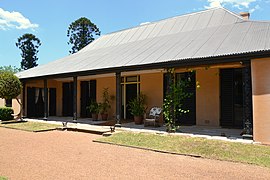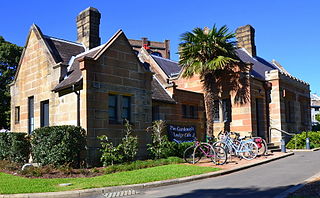
Victoria Park is a 9-hectare (22-acre) urban park situated on the corner of Parramatta Road and City Road, Camperdown, in the City of Sydney, New South Wales, Australia. The park is located adjacent to The University of Sydney and the Broadway Shopping Centre.

The New South Wales Office of Environment and Heritage (OEH), a former division of the Government of New South Wales between April 2011 and July 2019, was responsible for the care and protection of the environment and heritage, which includes the natural environment, Aboriginal country, culture and heritage, and built heritage in New South Wales, Australia. The OEH supported the community, business and government in protecting, strengthening and making the most of a healthy environment and economy within the state. The OEH was part of the Department of Planning and Environment cluster and managed national parks and reserves.
The Register of the National Estate was a heritage register that listed natural and cultural heritage places in Australia that was closed in 2007. Phasing out began in 2003, when the Australian National Heritage List and the Commonwealth Heritage List were created and by 2007 the Register had been replaced by these and various state and territory heritage registers.
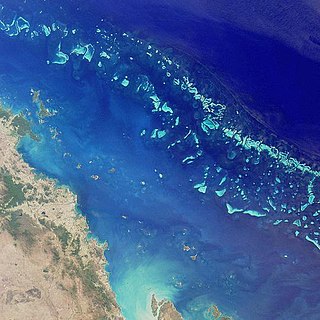
The Australian National Heritage List or National Heritage List (NHL) is a heritage register, a list of national heritage places deemed to be of outstanding heritage significance to Australia, established in 2003. The list includes natural and historic places, including those of cultural significance to Indigenous Australians such as Aboriginal Australian sacred sites. Having been assessed against a set list of criteria, once a place is put on the National Heritage List, the provisions of the Environment Protection and Biodiversity Conservation Act 1999 apply.
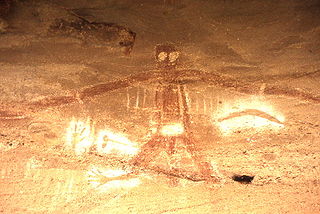
An Australian Aboriginal sacred site is a place deemed significant and meaningful by Aboriginal Australians based on their beliefs. It may include any feature in the landscape, and in coastal areas, these may lie underwater. The site's status is derived from an association with some aspect of social and cultural tradition, which is related to ancestral beings, collectively known as Dreamtime, who created both physical and social aspects of the world. The site may have its access restricted based on gender, clan or other Aboriginal grouping, or other factors.

Berry Museum is a heritage-listed former council chambers and bank building and now museum at 135 Queen Street, Berry, City of Shoalhaven, New South Wales, Australia. It was designed by William Wilkinson Wardell and built from 1884 to 1885 by W. Stoddart. It is also known as the E.S.&A. Bank or the ANZ Bank. The property is owned by Shoalhaven City Council. It was added to the New South Wales State Heritage Register on 1 September 2006.
Australian heritage laws exist at the national (Commonwealth) level, and at each of Australian Capital Territory, New South Wales, Northern Territory, Queensland, South Australia, Tasmania, Victoria, Western Australia state and territory levels. Generally there are separate laws governing Aboriginal cultural heritage and sacred sites, and historical heritage. State laws also allow heritage to be protected through local government regulations, such as planning schemes, as well.
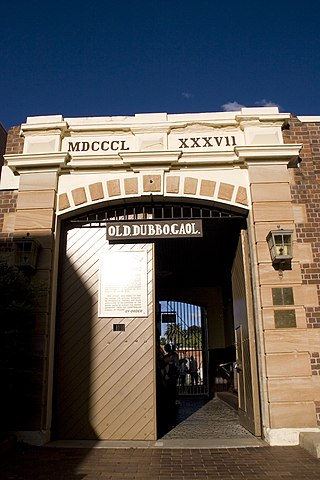
The Old Dubbo Gaol is a heritage-listed former gaol and now museum and tourist attraction at 90 Macquarie Street, Dubbo in the Dubbo Regional Council local government area of New South Wales, Australia. The gaol was designed by the NSW Colonial Architect's Office and was built from 1847 to 1945 by James Atkinson Jnr (1862–63) and William Bonython Moffatt. The gaol is also known as the Dubbo Jail and the Dubbo Gaol. The building was added to the New South Wales State Heritage Register on 26 March 2004. The building was the second gaol in Dubbo, replacing lockups built in 1847 and 1862.

Cape Byron Light, also called Cape Byron Lightstation, is an active heritage-listed lighthouse and now interpretative centre, interpretative space, maritime museum, administration office, retail building, accommodation, tourist attraction and visitor attraction located at Lighthouse Road, Byron Bay, Cape Byron, Byron Shire, New South Wales, Australia. It was designed by Charles Harding and Cecil W. Darley and built from 1899 to 1901 by Messrs Mitchell & King. It is also known as Cape Byron Lightstation, Byron Bay Lighthouse, Cape Byron Headlan and Cape Byron Headland Reserve. The property is owned by NSW National Parks & Wildlife Service.

The Manly Dam is a heritage-listed dam near King Street, Manly Vale with a reservoir extending into Allambie Heights, both in the Northern Beaches Council local government area of New South Wales, Australia. It is often used as a place to have recreational activities. The reservoir is located within the Manly Dam Reserve. The dam was designed by the NSW Department of Public Works and built in 1892 by the Department. The reservoir and dam is owned by Sydney Water, an agency of the Government of New South Wales. The reservoir and dam was added to the New South Wales State Heritage Register on 18 November 1999.

The Cliefden Caves is a heritage-listed geoheritage site in Mandurama, Cowra Shire, New South Wales, Australia. The caves comprise Ordovician fossil localities, limestone caves, a spring and tufa dams, and a site where limestone was first discovered in inland Australia.

Quirindi railway station is a heritage-listed railway station located on the Main Northern line in Quirindi in the Liverpool Plains Shire local government area of New South Wales, Australia. The station serves the town of Quirindi and opened on 13 August 1877 when the line was extended from Murrurundi. It was the terminus of the line until it was extended to West Tamworth on 14 October 1878. It is also known as Quirindi Railway Station group. The railway station was added to the New South Wales State Heritage Register on 2 April 1999.

Grave of Yuranigh is the heritage-listed grave of Yuranigh, a 19th-century Wiradjuri man. It is located 3 km south-east of Molong, Cabonne Shire, New South Wales, Australia and dates from 1852. It is also known as Yuranigh's grave. It was added to the New South Wales State Heritage Register on 10 March 2006.

The Karuah River bridge is a heritage-listed road bridge that carries the Weismantels-Dingadee Road across the Karuah River, located at Monkerai, New South Wales, Australia. The bridge is also known as the Monkerai Bridge over Karuah River. The bridge is owned by Transport for NSW. It was added to the New South Wales State Heritage Register on 20 June 2000.

The Abernethy and Co Stonemason's Lathe is a heritage-listed former stonemason's lathe located at Moruya and District Historical Society, 85 Campbell Street, Moruya in the Eurobodalla Shire local government area of New South Wales, Australia. It was built during 1881 by J. Abernethy & Co, Aberdeen. The property is owned by the Office of Environment and Heritage, an agency of the Government of New South Wales. It was added to the New South Wales State Heritage Register on 2 April 1999.
The Coxs River track is a heritage-listed former walking track and road and now walking track at Cox's River Arms, Lake Burragorang/Warragamba Dam, City of Blue Mountains, New South Wales, Australia. The track is also known as the Warragamba Dam - Burragorang Valley - Wentworth Falls Track. The property is owned by the Sydney Catchment Authority, an agency of the Government of New South Wales. It was added to the New South Wales State Heritage Register on 18 November 1999.

The Rocks branch of the English, Scottish and Australian Bank is a heritage-listed former bank building and now restaurant located at 131-135 George Street in the inner city Sydney suburb of The Rocks in the City of Sydney local government area of New South Wales, Australia. It was designed by William Wardell and built during 1886. It is also known as the English Scottish & Australian Chartered Bank (former) - Amo Roma Restaurant and Vault Restaurant; the Institute of Marine Power Engineers; Five Bells; and Ox on the Rocks. The property is owned by the Sydney Harbour Foreshore Authority, an agency of the Government of New South Wales. It was added to the New South Wales State Heritage Register on 10 May 2002.

The View Terrace facades are heritage-listed offices and a former residence and terrace houses located at 26-30 Gloucester Street, in the inner city Sydney suburb of The Rocks in the City of Sydney local government area of New South Wales, Australia. It was built from 1893 to 1893. It is also known as Formerly 22-30 Gloucester Street and part of 40 Gloucester Street development. The property is owned by Property NSW, an agency of the Government of New South Wales. It was added to the New South Wales State Heritage Register on 10 May 2002.

32-36 and 38-40 Gloucester Street facades, The Rocks is a heritage-listed former residence located at 32-36 and 38-40 Gloucester Street, in the inner city Sydney suburb of The Rocks in the City of Sydney local government area of New South Wales, Australia. It was built during 1885. It is also known as part of development known as 40 Gloucester Street. The property is owned by Property NSW, an agency of the Government of New South Wales. It was added to the New South Wales State Heritage Register on 10 May 2002.

105 George Street, The Rocks is a heritage-listed shop and former residence located at 105 George Street, in the inner city Sydney suburb of The Rocks in the City of Sydney local government area of New South Wales, Australia. It was built during 1851 by persons unknown and redeveloped in 1985 by the Sydney Cove Redevelopment Authority with Co-Wyn Construction. It is also known as Kathmandu (current) and Beach Culture and Dorian Scott (former). Property NSW, an agency of the Government of New South Wales. It was added to the New South Wales State Heritage Register on 10 May 2002.
